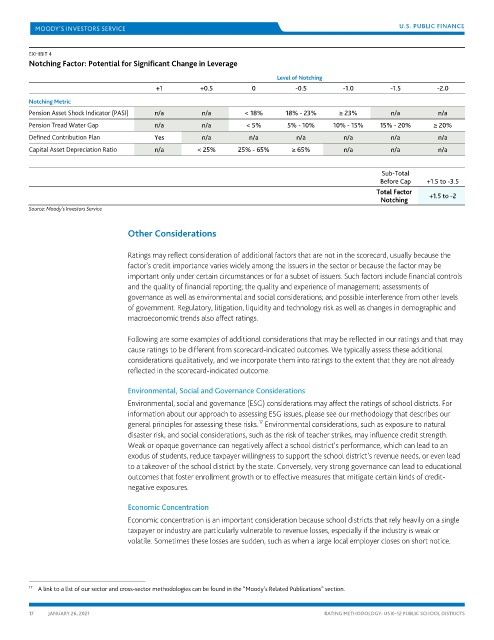Page 1651 - draft
P. 1651
U.S. PUBLIC FINANCE
EXHIBIT 4
Notching Factor: Potential for Significant Change in Leverage
Level of Notching
+1 +0.5 0 -0.5 -1.0 -1.5 -2.0
Notching Metric
Pension Asset Shock Indicator (PASI) n/a n/a < 18% 18% - 23% ≥ 23% n/a n/a
Pension Tread Water Gap n/a n/a < 5% 5% - 10% 10% - 15% 15% - 20% ≥ 20%
Defined Contribution Plan Yes n/a n/a n/a n/a n/a n/a
Capital Asset Depreciation Ratio n/a < 25% 25% - 65% ≥ 65% n/a n/a n/a
Sub-Total
Before Cap +1.5 to -3.5
Total Factor +1.5 to -2
Notching
Source: Moody’s Investors Service
Other Considerations
Ratings may reflect consideration of additional factors that are not in the scorecard, usually because the
factor’s credit importance varies widely among the issuers in the sector or because the factor may be
important only under certain circumstances or for a subset of issuers. Such factors include financial controls
and the quality of financial reporting; the quality and experience of management; assessments of
governance as well as environmental and social considerations; and possible interference from other levels
of government. Regulatory, litigation, liquidity and technology risk as well as changes in demographic and
macroeconomic trends also affect ratings.
Following are some examples of additional considerations that may be reflected in our ratings and that may
cause ratings to be different from scorecard-indicated outcomes. We typically assess these additional
considerations qualitatively, and we incorporate them into ratings to the extent that they are not already
reflected in the scorecard-indicated outcome.
Environmental, Social and Governance Considerations
Environmental, social and governance (ESG) considerations may affect the ratings of school districts. For
information about our approach to assessing ESG issues, please see our methodology that describes our
17
general principles for assessing these risks. Environmental considerations, such as exposure to natural
disaster risk, and social considerations, such as the risk of teacher strikes, may influence credit strength.
Weak or opaque governance can negatively affect a school district’s performance, which can lead to an
exodus of students, reduce taxpayer willingness to support the school district’s revenue needs, or even lead
to a takeover of the school district by the state. Conversely, very strong governance can lead to educational
outcomes that foster enrollment growth or to effective measures that mitigate certain kinds of credit-
negative exposures.
Economic Concentration
Economic concentration is an important consideration because school districts that rely heavily on a single
taxpayer or industry are particularly vulnerable to revenue losses, especially if the industry is weak or
volatile. Sometimes these losses are sudden, such as when a large local employer closes on short notice.
17 A link to a list of our sector and cross-sector methodologies can be found in the “Moody’s Related Publications” section.
17 JANUARY 26, 2021 RATING METHODOLOGY: US K–12 PUBLIC SCHOOL DISTRICTS

